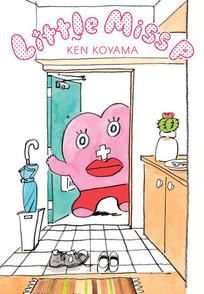Review
by Rebecca Silverman,Little Miss P
GN
| Synopsis: |  |
||
Once a month, she comes to visit. Whether you call her Aunt Flo or Little Miss P, her arrival is met with anything but glee by most women. But despite her gut punches and mood swings, Little Miss P is a fact of reproductive life, and we all have to cope with her visits in our own ways, as this collection of short stories on the theme of menstruation shows. |
|||
| Review: | |||
If the very thought of menstruation is uncomfortable for you or grosses you out, Little Miss P is not the book for you. That may seem obvious, given that the eponymous character is an anthropomorphized period, but it's also part of the manga's mission in a way – to start a discussion about something that happens to a little over half the population but that no one really wants to bring up. It's an issue in many countries, and the fact that Japan has had menstrual leave for women since 1947 doesn't mean that it's any less of a taboo topic there. (Despite the leave's availability, many women don't take it for fear of being seen as weak or just people knowing they have their periods.) This is made most obvious by the final full-length chapter in the book, a fictionalized biography of Yoshiko Sakai, the woman who first brought sanitary napkins to Japanese women in the 1960s – forty years after they were available in the west. Apart from the horrible idea of vinyl underwear pre-Sakai, there's one more piece of the chapter that's especially striking and may not sit well with all readers. Sakai named her products (which later also included tampons) “Anne's Day” – after Anne Frank. This is largely due to the fact (scholars say) that the Japanese translation of Anne's diary was the first time that many Japanese women had seen someone not only frankly discuss but look forward to menarche; in other words, not to see it as a particular shame, but as a good thing. This resonated with them and eventually lead Sakai to call her sanitary products after the Holocaust victim, and it may also be part of the reason Anne's story is so popular in Japan. But for western readers, it's not necessarily a comfortable correlation, regardless how you feel about periods, since it comes off as commercializing Frank. That aside, it's interesting how little the stories actually deal with the actual substance of periods that make them so unpleasant for people to think or talk about – that is, the fact that blood comes out of the vagina. There's only one chapter that actually discusses blood, when a woman's boyfriend, who is a single dad, calls her for help because his daughter got her first period. The girl's bled on the couch, which freaked both her and her dad out, but apart from that, blood doesn't really come up. Instead, the focus is more on the physical discomforts or the annoyances of getting your period, which quite honestly can be the much bigger issue. It isn't quite as Frank as Sarah Andersen's angry uterus comics, but it's also created for an audience not as used to, or comfortable with, such material. As such, it does at times read as something that doesn't quite go as far as it needs to, but it gets the job done in terms of starting the conversation. Certainly Little Miss P's “period punch” is a vivid illustration – in the most memorable, her cramp-inducing hit actually punches a hole in someone's side, which can definitely be what it feels like. The personified period isn't the only character to appear in the stories; sometimes she is joined by Mr. Libido and Mr. Virginity, and Little Miss PMS features in a closing short. Mr. Libido is drawn to resemble a penis, and he does tend to just show up for male characters, which is unfortunate. (His vocabulary, which consists entirely of lines like “Fap fap” and “3P,” however, is kind of funny.) Mr. Virginity is drawn as a square, possibly in reference to the “V Card” of slang, and his appearances are much more equal in terms of gender. Interestingly, Mr. Libido's main role is in the chapter where Little Miss P forces a boy to switch bodies with a girl he's bugging so that he can experience what she goes through during her period – and she gets to experience his hormonal issues. It's a story that seeks to build an understanding that both boys and girls go through their own problems, and that it's important for us to know that…even if girls, it seems to imply, have it worse. Perhaps the most striking part about this book is related to that – in stories where there is more than one character, everyone acknowledges Little Miss P's presence. No screams or says she's gross or orders her out; she's just a fact of life. Little Miss P herself can be seen working towards that acceptance in the story set in the Edo period (when menstruation huts were still in use). And that's really the end goal of the volume: periods happen. Lots of people get them. So why don't we just talk about it? |
| Grade: | |||
|
Overall : B
Story : B
Art : C
+ Encourages frank discussion, covers a fair number of situations |
|||
| discuss this in the forum (3 posts) | | |||
| Production Info: | ||
|
Full encyclopedia details about Release information about |
||